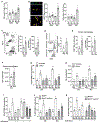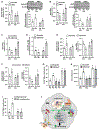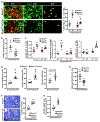Efferocytosis induces macrophage proliferation to help resolve tissue injury
- PMID: 34784501
- PMCID: PMC8665147
- DOI: 10.1016/j.cmet.2021.10.015
Efferocytosis induces macrophage proliferation to help resolve tissue injury
Abstract
Apoptotic cell clearance by macrophages (efferocytosis) promotes resolution signaling pathways, which can be triggered by molecules derived from the phagolysosomal degradation of apoptotic cells. We show here that nucleotides derived from the hydrolysis of apoptotic cell DNA by phagolysosomal DNase2a activate a DNA-PKcs-mTORC2/Rictor pathway that increases Myc to promote non-inflammatory macrophage proliferation. Efferocytosis-induced proliferation expands the pool of resolving macrophages in vitro and in mice, including zymosan-induced peritonitis, dexamethasone-induced thymocyte apoptosis, and atherosclerosis regression. In the dexamethasone-thymus model, hematopoietic Rictor deletion blocked efferocytosing macrophage proliferation, apoptotic cell clearance, and tissue resolution. In atherosclerosis regression, silencing macrophage Rictor or DNase2a blocked efferocyte proliferation, apoptotic cell clearance, and plaque stabilization. In view of previous work showing that other types of apoptotic cell cargo can promote resolution in individual efferocytosing macrophages, the findings here suggest that signaling-triggered apoptotic cell-derived nucleotides can amplify this benefit by increasing the number of these macrophages.
Keywords: DNase2a; Erk1/2 signaling; MerTK; Myc; atherosclerosis; efferocytosis; inflammation resolution; mTORC2/Rictor; macrophage; macrophage proliferation.
Copyright © 2021 Elsevier Inc. All rights reserved.
Conflict of interest statement
Declaration of interests The authors declare no competing interests.
Figures







References
-
- Alliot F, Godin I, and Pessac B (1999). Microglia derive from progenitors, originating from the yolk sac, and which proliferate in the brain. Brain Res Dev Brain Res 117, 145–152. - PubMed
Publication types
MeSH terms
Grants and funding
- S10 RR027050/RR/NCRR NIH HHS/United States
- R35 HL145228/HL/NHLBI NIH HHS/United States
- S10 RR025686/RR/NCRR NIH HHS/United States
- R01 HL127464/HL/NHLBI NIH HHS/United States
- P30 CA013696/CA/NCI NIH HHS/United States
- P01 HL087123/HL/NHLBI NIH HHS/United States
- UL1 TR001873/TR/NCATS NIH HHS/United States
- R01 HL159012/HL/NHLBI NIH HHS/United States
- K99 HL145131/HL/NHLBI NIH HHS/United States
- S10 OD020056/OD/NIH HHS/United States
- T32 HL007343/HL/NHLBI NIH HHS/United States
- P20 GM121307/GM/NIGMS NIH HHS/United States
LinkOut - more resources
Full Text Sources
Other Literature Sources
Molecular Biology Databases
Miscellaneous

